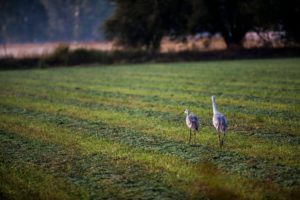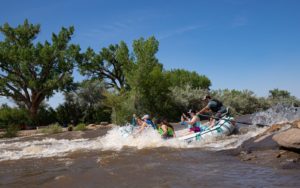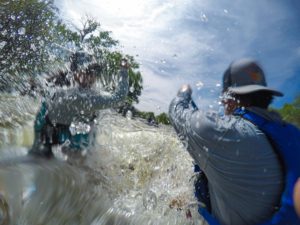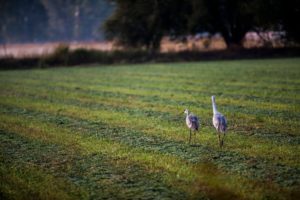Governor Michelle Lujan Grisham Delivering for Communities in San Juan and Animas River Watersheds
$10 million in grant funding available for projects that restore or replace injured natural resources or the services they provide
Listen to this information in Diné
Introduction
Seven years after the release of millions of gallons of acid mine drainage and tons of toxic metals from the Gold King Mine in Colorado, Gov. Michelle Lujan Grisham and New Mexico Natural Resources Trustee Maggie Hart Stebbins opened the application process for projects that will use the $10 million received from the federal government as part of the Gold King Mine Settlement that was reached in June 2022 for restoration of injured natural resources.

History & Impact of the Spill
On Aug. 5, 2015, the United States Environmental Protection Agency (“U.S. EPA”) and contractors working on U.S. EPA’s behalf caused a release of millions of gallons of acid mine drainage and tons of toxic metals from the Gold King Mine in Colorado. The plume of contaminated water from the release caused the Animas and San Juan Rivers to turn bright yellow through Colorado, New Mexico and the Navajo Nation to Lake Powell in Utah. The release also forced communities to close intakes for drinking water systems, prompted many farmers to stop irrigating their crops, and drastically decreased recreational use of the rivers.

A Resilient Region
Outdoor activities are a primary driver of tourism in this region of New Mexico. Over the last 5 years, between 50-60% of all overnight trips include some form of outdoor activity. Fishing is a particularly important driver of tourism in the area. On average, about 10% of overnight trips to this region involved fishing—nearly twice the average for the rest of the state. The Gold King Mine spill had a significant impact on recreational tourism in this area, and although the rivers are now safe for farming, outdoor activities and other uses, the stigma associated with the event has had lasting effects on the region’s economy.

How to Apply
Organizations should review the project solicitation information here and submit funding proposals by Friday, October 28th at 5:00 PM (MST) using the form provided here.
Types of Projects Eligible for Funding
The funding will be distributed through a competitive application process and will be available for projects that restore or replace injured natural resources or the services they provide. Eligible projects may include, among other things, river, land, habitat, and watershed restoration and conservation, or projects that compensate the public for the loss of use of natural resources following the 2015 Gold King Mine release. Project proposals are being accepted online from now until Friday, October 28th, 2022 at 5:00 PM (MST).
Local public bodies and State agencies are encouraged are encouraged to submit proposals that use this funding for the benefit and restoration of natural resources, outdoor recreation, and farming across the San Juan and Animas Watersheds in Northwest New Mexico. ONRT encourages non-governmental entities seeking restoration project funding to partner with local or state public entities. ONRT will prioritize project proposals that are shovel ready, can be implemented within a year, and completed within 3 years.
Questions and Assistance
To answer questions and assist potential applicants with the application process, ONRT hosted an optional webinar on Wednesday, Aug. 24, 2022. Interested applicants are strongly encouraged to view the webinar recording here.

State and local collaboration
Since taking office in 2019, the administration of Michelle Lujan Grisham, along the New Mexico Attorney General, the New Mexico Environment Department, and the ONRT coordinated closely to hold EPA, its contractors, and the mine owners accountable and bring closure and restoration to residents. In addition to the $32 million settlement with the federal government announced by the governor in June, an $11 million settlement was reached with the mining defendants last year.
In total, over $43 million has come from those settlements to New Mexico to make the state whole following the Gold King Mine Spill.
Aside from the litigation, the State of New Mexico has supported the region through more than $6.3 million in direct and leveraged funding, including:
- $1.9 million from the Job Training Assistance Program to train 180 new PESCO employees in Farmington.
- $1.8 million to San Juan County for the extension of a natural gas pipeline 11 miles to the San Juan County Industrial Park.
- $1 million for restoration projects to compensate the public in the San Juan and Animas region for injuries caused by the 2015 release.
- $186,200 from the New Mexico Department of Agriculture Specialty Crop Block Grant Program to develop the Northwest New Mexico New Farmer Network. The project aims to identify available farm sites in San Juan County, connect new farmers to available land, and provide technical and lease facilitation assistance to further support the agriculture industry in the Four Corners region.
- $182,038 from the USDA Farmers Market Promotion Program Grant to San Juan College to assist the Northwest New Mexico Growers Market Alliance with bringing efficiency and organization to the regional markets.
- $135,000 from New Mexico MainStreet to renovate the Totah Theater in downtown Farmington.
- $122,180 in annual funding from the NMDA Agricultural Programs and Resources Division to support the San Juan County and the San Juan Soil and Water Conservation District in an ongoing collaboration remove of nonnative plant species from infested areas. The total annual funds received by San Juan County since 2019 is $488,720.
- $113,721 from the New Mexico Department of Agriculture Specialty Crop Block Grant Program to the Growing Forward Farm Project to develop vacant land into a hands-on agricultural training center for farmers, ranchers, youth and local gardeners.
- $50,000 from Water Infrastructure Improvements for the Nation Act funding to the San Juan Soil and Water Conservation District for the Know Your Farmer Campaign to create a marketing campaign that improves the perception of agricultural products in NWNM after the Gold King Mine Spill.
- $37,000 in Local Economic Assistance & Development Support Program funding to the City of Farmington to purchase modular units to house local businesses selling their products and to construct a covered pavilion in a nearby parking lot.
- $13,000 from the Economic Development Department’s Outdoor Recreation Division to Global Opportunities Unlimited to teach fishing and wildlife conservation to children with mobility and access challenges.

